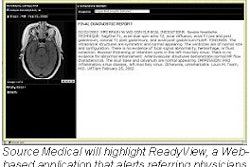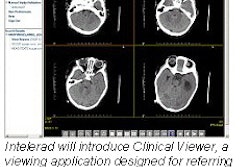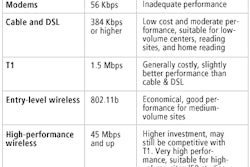CHICAGO - Coming off a completed restructuring process announced at the 2001 RSNA meeting, Eastman Kodak Health Imaging is armed with a range of technology introductions in its booth this year.
The Rochester, NY-based firm is devoting considerable booth space to its new PACS strategy, which leverages a technology partnership with Israeli PACS vendor Algotec.
"We are back in the PACS game big time, and are investing heavily in it," president Dan Kerpelman told AuntMinnie.com. "We've chosen a relationship with Algotec because we believe that was the right way to complement things that we had quickly and effectively."
The relationship is already bearing fruit, headlined by Kodak's work-in-progress Web-based System 5 architecture. The first step in the conversion from Kodak's legacy digital image management architecture to System 5, however, will be the vendor's new Web distribution system for dissemination of images and reports.
Employing the same database used with System 5, the Web distribution system can run off PC and Macintosh platforms and from Internet Explorer or Netscape browsers. Interfacing with PACS networks from Kodak and other vendors, the offering supports clinical image review on dual-monitor, high-resolution workstations.
Lossless and lossy (wavelet) compression will be supported, as well as the ability to convert from lossy to lossless with a single mouse click, Kodak said. Variable lossy compression rates are also performed based on anatomy present in each image, as are progressive downloads of imaging studies. The system will begin shipping to customers in the first quarter of 2003.
System 5
System 5 will include functionality such as image "push" and "pull" models, as well as a central database that manages a flexible configuration of local and distributed storage, according to the firm. The software suite can reside on a single-server platform, or be replicated across multiple platform hosts. An HL7 interface allows for HIS and RIS integration.
E-mail-based distribution of reports and key images will also be available, including an optional Web page link for physicians to access an entire imaging study. System 5 will be commercially released in the second half of 2003.
Kodak has committed to an upgrade path for existing Kodak PACS customers. The series of upgrades will begin with the Web distribution system, said Michael Fiske, worldwide category manager for PaRis.
In digital x-ray, the Rochester, NY-based vendor is highlighting CR 850, a single-cassette offering. The new reader includes a number of enhancements over the firm's CR 800 system, which it will replace in the Kodak CR arsenal. It has a capacity of 100 cassettes per hour, compared to 70 cassettes per hour for CR 800, said Richard Jebo, general manager, computed radiography and digitizer products.
Other new features include reject analysis, improved procedure mapping, and the ability to set up procedure codes. A new, 15-inch flat-panel display includes increased brightness and contrast, while a bar-code reader takes care of patient and cassette identification, Kodak said.
CR 850 also supports the firm's remote operations panels (ROPs), which allow patient and cassette identification, image review, and image distribution to be performed in the exam room. Suitable for ER, ICU, and areas with limited floor space, CR 850 has a footprint of 25 x 29 inches, Kodak said. It will begin shipping in the second quarter of 2003.
The vendor is also pointing booth visitors to a long-length CR system that enables digital capture of full leg and spine images from a wall-mounted vertical cassette holder, which can hold two, three, or four cassettes. Working in combination with Kodak's CR 800 or CR 900 series readers, the system utilizes an automatic stitching software package to produce images up to 17 x 51 inches with over 99% stitching accuracy, the vendor said.
Kodak believes that the software reduces problems such as poor stitching, incorrect alignment, or misordered images. Viewable in both soft-copy or hard-copy format, an optional DirectView software package for CR 800 or CR 900 allows DryView laser imagers to print a true-size image from anywhere within a composite long-length image, the vendor said. Up to four-true size segments can be printed to form a composite long-length image.
Kodak's EVP image processing software is available as an option on the system, as is a 17 x 51-inch grid, the company said. Including the cassette holder, four cassettes, and one software license, the long-length system has a list price of $15,000. Kodak plans to begin shipping the system this month.
In DR developments, the firm has begun shipping its DR 5100 system, which is designed for chest and other upright studies for ambulatory and nonambulatory patients. The amorphous selenium-based DR 5100 includes an integrated touch-screen operator console, a new high-frequency 80 kW generator, bucky and tube stand, and the firm's PTS software, with an option for EVP software.
Images can be reviewed within 12 seconds of exposure for quality assurance, with an image cycle time of 35 seconds. DR 5100 lists for $350,000, said Steven Romocki, worldwide marketing manager for digital products and solutions.
The next Kodak DR system to hit the market will be DR 7100, a single-detector, general radiography system with a tilt table and overhead tube. Shipments are expected to begin in the first quarter, Romocki said. DR 7100 will have a list price of $415,000.
DR 9000, a general radiography system, includes a U-arm design with a full range of motion for chest, extremity, abdominal, and trauma exams, Kodak said. The system will list for $450,000.
In other introductions, Kodak is unveiling DryView 8900, the firm's new flagship dry laser imager. DryView 8900 outputs more than 180 films per hour at 650 dots per inch.
The printer's 650-dpi resolution is available on all film sizes, said Gregory Cefalo, worldwide marketing manager for laser imaging systems. The imager contains three film drawers and supports five film sizes: 14 x 17, 14 x 14, 11 x 14, 10 x 12, and 8 x 10 inches.
Kodak believes DryView 8900 is suitable for centralized printing in busy multimodality areas. It will begin shipping in the second half of 2003. The vendor is also showcasing a new X-Sight screen, which produces images that are approximately 20% sharper than the previous X-Sight film and screen system, Kodak said.
In its professional services business, Kodak has added DirectView Secure Remote Service Access (SRSA), a virtual-private-network-based remote service offering. SRSA includes a secure, high-speed link to Kodak PACS, DR, and CR systems, allowing for many service and preventive maintenance tasks to be performed remotely, Kodak said.
By Erik L. Ridley
AuntMinnie.com
staff writer
December
5, 2002
Related Reading
Los Alamos using Kodak software for brain research, November 27, 2002
Kodak inks NY, NJ, VA deals, November 20, 2002
Kodak promotes Ferrell, November 19, 2002
Kodak nets VA contract, November 12, 2002
Kodak sues Agfa for film patent infringement, November 5, 2002
Copyright © 2002 AuntMinnie.com



















